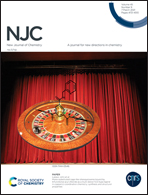Regioisomeric BODIPY derivatives: second-order nonlinear optical properties under an external electric field†
Abstract
The present work aims to study the effect of an external electric field as well as arrangement of donor–acceptor groups on the second-order nonlinear optical (NLO) properties of push–pull systems. The first hyperpolarizabilities (βtot) of acceptor–donor molecules (m-AD and p-AD regioisomers) are investigated based on 4,4-difluoro-4-bora-3a,4a-diaza-s-indacene (BODIPY) as the electron-acceptor and benzodithiophene (BDT) as the electron-donor. Calculated results show that the βtot value (7.49 × 103 a.u.) of p-AD is larger than that (1.03 × 103 a.u.) of m-AD. Furthermore, we investigate that the external electric fields (along the positive or the negative directions of x-axis, Fx and F−x) regulate the NLO properties of the p-AD. (1) As Fx increases, the βtot values of p-AD are gradually decreased to 0 (Fx ranging from 0 to 30 × 10−4 a.u.). (2) As F−x increases, the βtot values are sharply increased (F−x ranging from 0 to −30 × 10−4 a.u.). It is worth noting that the βtot value is increased to 3.70 × 104 a.u. (F−x = −30 × 10−4 a.u.). Moreover, the evolutions of the simulated UV-Vis absorption spectra can well explain the trends of βtot values under an external electric field. The present work not only provides a deeper understanding of the relationship between structure and NLO properties, but also expands electric field-induced switchable NLO materials.



 Please wait while we load your content...
Please wait while we load your content...